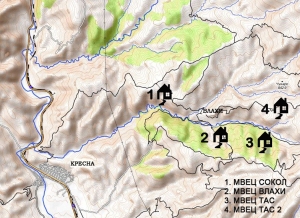В изпълнение на програмата на Сдружение Балканка за спасяване на Българските реки от убийственото влияние на ВЕЦ-овете у нас, във връзка с поетия ангажимент да помагаме на структурите на МОСВ и БД, представяме доклад относно посетени и проверени съоръжения, преграждащи речни корита на територията на БЗУВЗБР.
Преди доклада, се налага да коментираме вчерашното събитие, наречено Обеществено обсъждане на ПУРБ и ПУРН на ЗБР, споделяйки нашето дълбоко разочарование от това, на което станахме свидетели.
Разбира се, че не бяхме подготвени да присъстваме там, за да изслушаме подробната лекция на тема действащо законодателство, изнесена с назидателен тон от г-жа Вангелия Иванова, още повече че познаваме законодателството до необходимата степен. Нито бяхме готови да слушаме непрекъснато, че заплатите на БДУВЗБР се плащат само от икономическите субекти в района, поради което единствените критерии за взимане на решения в ЗБР са икономическите интереси. Че икономическите интереси взимат решения в ЗБР вече сме се убедили, но се надяваме поне това със заплатите да не е вярно.
По-лошото е, че всичките ни предложения бяха отхвърлени, с мотиви и основания, които не можем да приемем. Само няколко примера:
1. За зоните за защита на водите за опазване на стопански ценни видове риби - щяло да се постигне добро състояние на водните тела и така щели да се възстановят рибните популации в критично състояние, определящи настоящото състояние като лошо? Е, как ще го постигнете това добро състояние, като нямате никакви мерки?
2. По-лошата новина - мерките, предвидени в ПУРБ на ЗБР относно Петровска река щели да бъдат изпълнени чак през 2021г.? Тези мерки, всъщност, трябва да поправят вредата от едно разрешение за водовземане/ползване на БДУВЗБР, издадено в нарушение на ЗВ. Можем да споделим какво би следвало да се направи, за да се спазят закоодателството и общественият интерес, но очевидно е безмислено. Само ще напомним, че подобни мерки са записани и в стария ПУРБ, срокът на разрешителното е трябвало да се удължи преди 18.01.2015 и поне тогава мерките е трябвало да бъдат изпълнени под ръководството на директора на БДУВЗБР, но не са.
3. Никакви мерки не са и няма да бъдат предвидени в ПУРБ за водовземанията на водните обекти на територията на НПРила, след които реките са сухи като барут.
4. Няма да бъдат предвидени смекчаващи мерки за водните тела, като - разрушаване на ненужни миграционни бариери и изграждане на рибни проходи на останалите, които нямат. Въпреки че дори БДЗБР призна за вярно нашето твърдение, че във всички чуждестранни ПУРБ такива мерки има предвидени
5. Няма да бъдат предвидени мерки при маловодие - да се спира отнемането на вода от реките. Подобни заповеди са издавани в предходни години, но при друго ръководство на БДУВЗБР, а г-жа Иванова сподели своите виждания, че такова нещо не може да бъде правено.
6. Единствено не разбрахме какво точно стана с предложението - всички водовземания да се преработят така, че водното количество да може да бъде измервано. Надяваме се да осъзнавате, че никакво опазване на водите не може да се осъществява, след като ползвателите не могат да измерват водата, която изпускат, а БДУВЗБР също не може да я измерва, за да ги контролира. Въпреки че за всички наши сигнали през миналата година г-жа Иванова бодро отговаряше, че при техни проверки екологичният минимум е бил изпускан навсякъде, а само на Петровска река имаше измервателна рейка, но не за водата, която отива в реката, а за водата в канала.
И все пак, въпреки че за първи път ставаме свидетели на обществено обсъждане, на което всички предложения се отхвърлят, ние донякъде бяхме подготвени, че това ще стане. Славата на ръководителя на БДУВЗБР беше достигнала и до нас, така да се каже.
Но трябва да споделим дълбокото си възмущение от това, което се случи с предложението на нащите приятели от Българско Каяк Общество, които не познават достатъчно подробно законодателството и г-жа Иванова.
Става дума за тяхното предложение - осем километров участък от Струма в Кресненското дефиле да се обяви като зона за защита на водите, определена за отдих и водни спортове.
От гледна точка на закона за водите, считаме за напълно правилно изявлението на г-жа Иванова, че областният управител определя такива зони. Но, доколкото тези зони се описват и в ПУРБ, считаме, че всеки нормален ръководител на БД, който трябва да се грижи и за обществения интерес, а не само на интереса на бизнеса, би могъл да не чака да го молят коленопреклонно да бъдат включени такива зони в ПУРБ, а би могъл да обсъди въпроса с областния управител и да направи необходимите предложения, за да бъдат записани зоните в ПУРБ. Излежда БДУВЗБР, концентрирана да угажда само на икономическите субекти, не знае за Кресненското дефиле - най-култовото място за водни спортове у нас.
Най-обидното е, че членовете на БКО помагат при всяко наводнение и вадят хора от най-опасните и трудни за достъп места, докато министри, областни управители и ръководители на БД дават интервюта пред телевизиите за действията, които се предприемат.
Съзнаваме много добре, че ръководството на БДУВЗБР е свикнало, всеки който иска да отправи предложение, да се моли ниско наведен, но свободните хора не се навеждат. От БКО внесоха вчера и писмено предложение в БДУВЗБР, дано някой да помогне на г-жа Иванова за взимане на правилното решение.
На фона на описаното, напълно разбираемо е, че единственото съпричастие, проявено от г-жа Иванова, бе изразено относно предложение на оператора на каскада Благоевградска Бистрица за изграждане на изравнител на реката, придружено от подробно описание на процедурата, по която това може да стане, без да се споменава, че такива неща не се отразяват в ПУРБ. Допускаме, че тя не се е сетила и за наличието на една действаща и няколко бъдещи ВЕЦ на същата река, които ще останат на сухо, затова просто го отбелязваме с цел облекчаване взаимодействието на БДУВЗБР с всички икономически субекти в района, а не само с един.
За отбелязване е и следният интересен феномен:
След като за ПУРБ бяхме обвинени, чи задваме прекалено много въпроси, въпреки че изчакахме малко, за да може някой друг да започне пръв, за ПУРН чакахме почти две минути и никой не зададе въпрос. Чак след като се престрашихме, представител на гр.Сандански несмело попита нещо след нас... Но най-лошото е, че абсолютно никой от залата не изказа похвала за разглежданите планове, за да оправдае високото самомнение на авторите им.
Що се отнася до нас, ние считаме, че ПУРБ на ЗБР е най-зле направения план, в сравнение с ПУРБ на всички останали басейнови дирекции и не бива да бъде приеман. Толкова по-зле за авторите му, че не приеха никакви предложения и още по-зле, че същата БДУВЗБР е партньор по проекта на нашите приятели от РЕЦ - ANCHOR за доказване на устойчивостта.
Въз основа на гореизложеното, доколкото директорът на БЗУВЗБР би следвало да провежда държавната политика за управление на водите на басейново ниво /чл.154, ал.3 от ЗВ/, считаме, че настоящият директор на БДУВЗБР - г-жа Вангелия Иванова, си е сбъркала местоработата. Защото въпросната държавна политика се очаква да предвижда обща и равна възможност за ползване на водите от всички български граждани и/или икономически субекти, да не говорим за насърчаване на взаимодействието с НПО, особено с тези от тях, които не се редят на държавната хранилка и смеят да имат собствено мнение. Ето защо, считаме, че г-жа Вангелия Иванова е много подходяща за най-висока длъжност в областта на енергетиката, но не и за длъжността, която заема понастоящем.
И сега - към основния доклад.
При предходни наши посещения в Благоевград, наблюдавахме част от новите съоръжения, изградени в реката. Става дума за дейностите извършени в рамките на парка Бачиново - рибни проходи и други защитни мерки в речното корито.
Обърнахме специално внимание на рибните проходи. Ето какво установихме при посещение в средата на януари 2015 при нормално ниво на реката за сезона:
https://www.youtube.com/watch?v=dEYKs0ieXFg
Надяваме се да забелязвате, че през прохода не преминава вода, следователно риби не могат да минат при нормално ниво на реката.
А ето какво установихме вчера при пълноводие, след „Общественото" обсъждане:
https://www.youtube.com/watch?v=rajBp2G81S8
https://www.youtube.com/watch?v=NIcsekQmfk0
https://www.youtube.com/watch?v=PLV8_DUifWo&feature=youtu.be
През рибния проход водата фучи и трещи, и отново никакви риби не могат да минат.
Длъжни сме също да споделим, че типа, геометрията и местоположението на прохода не са подходящо избрани.
Разбира се, вече не смеем да предложим никакви мерки, нито ще питаме защо са изхарчени безмислено обществени средства, защото е ясно какво ще ни отговорят.
Накрая - ние се справяме и ще се справим с нашите цели сами. Но искрено се надяваме някой да помогне на приятелите ни - каякарите, защото тези хора са много полезни, когато се наложи. Дано не се случва, но сме сигурни, че пак ще помагат, дори и на територията на БДУВЗБР...
Благодарим за разбирането и съдействието




 дяловете на „Бийстън енерджи“ притежава Иван Пушкаров – икономически министър в две правителства от началото на прехода.
дяловете на „Бийстън енерджи“ притежава Иван Пушкаров – икономически министър в две правителства от началото на прехода.




































